How to Choose the Perfect Living Room Chandelier (UK Guide 2025)
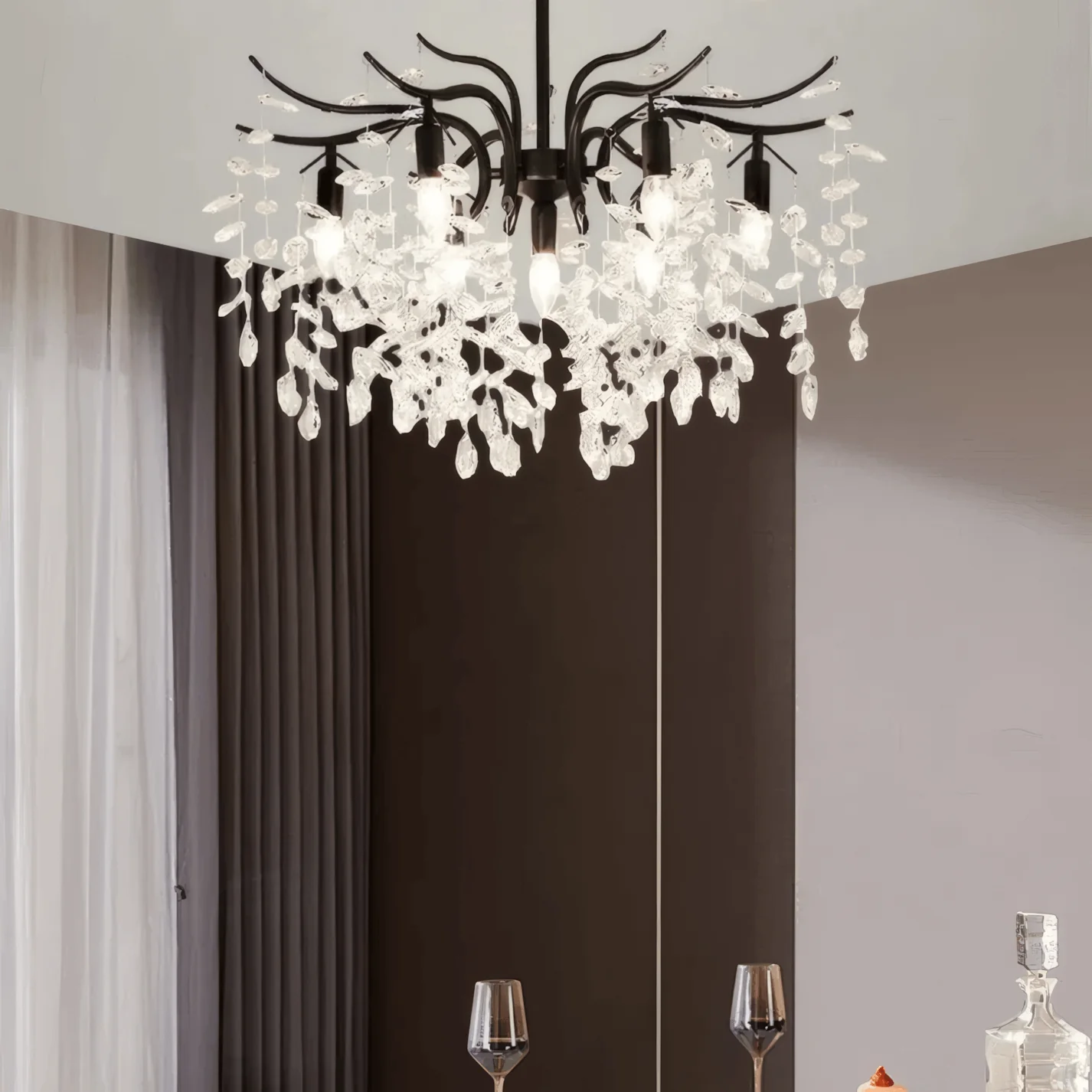
Have you ever thought about how chandelier lights can completely transform your living room? They’re not just functional but also serve as stunning focal points, much like art pieces. With the global market for chandeliers expected to reach $42.49 billion by 2025, it’s clear that more homeowners are embracing these elegant fixtures. Whether your style leans modern or traditional, the right chandelier can enhance your décor and create a warm, inviting ambience. By choosing thoughtfully, you’ll turn your modern living room into a space that feels both stylish and personal.
Key Takeaways
Chandeliers are stylish centrepieces that make your living room look better.
Pick a chandelier that matches your décor, like modern or vintage.
Think about ceiling height and room size to choose the right one.
Dimmable chandeliers let you change brightness for any mood or event.
LED bulbs save energy and last long, so they’re a smart choice.
Place your chandelier above a table or seating area for balance.
Plan your budget first to get a chandelier you like without overspending.
Check second-hand or DIY options for unique chandeliers with personality.
The Impact of Chandelier Lights on Your Living Room
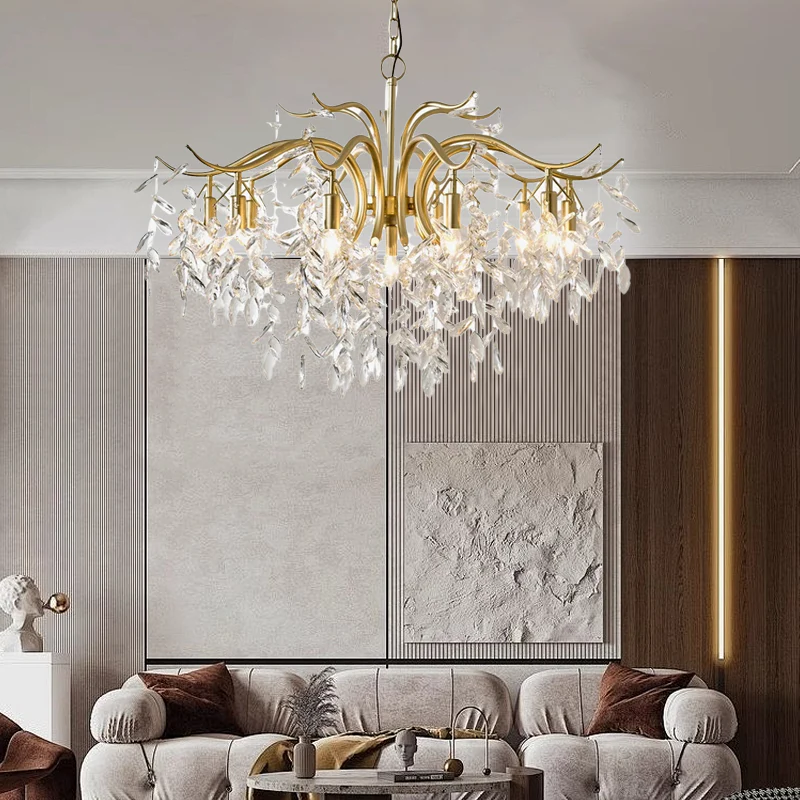
Enhancing Style and Elegance
Chandeliers are more than just light fixtures; they’re a statement of elegance. When you add one to your living room, it instantly elevates the space. Whether you prefer a sleek, modern design or a more traditional look, a chandelier can complement your décor beautifully. Imagine a crystal chandelier catching the light and creating a dazzling effect—it’s like adding a touch of luxury to your home. Even budget-friendly options can bring style and sophistication, proving that elegance doesn’t have to come with a hefty price tag.
Creating a Warm and Inviting Ambience
The right chandelier lights can transform your living room into a cosy retreat. They don’t just brighten the space; they create a mood. A warm glow from a chandelier can make your living room feel more inviting, perfect for relaxing evenings or entertaining guests. Modern chandeliers often come with dimming features, allowing you to adjust the lighting to suit the occasion. From rustic designs to sleek, contemporary styles, there’s a chandelier for every taste. You’ll find that these lights aren’t just for show—they’re functional too, blending aesthetics with practicality.
Chandeliers are no longer confined to dining rooms or grand halls. They’ve found their way into kitchens, bedrooms, and, of course, living rooms. Hotels often use chandeliers to enhance the warmth of their lobbies, creating a welcoming atmosphere for guests. Why not bring that same inviting ambience into your home?
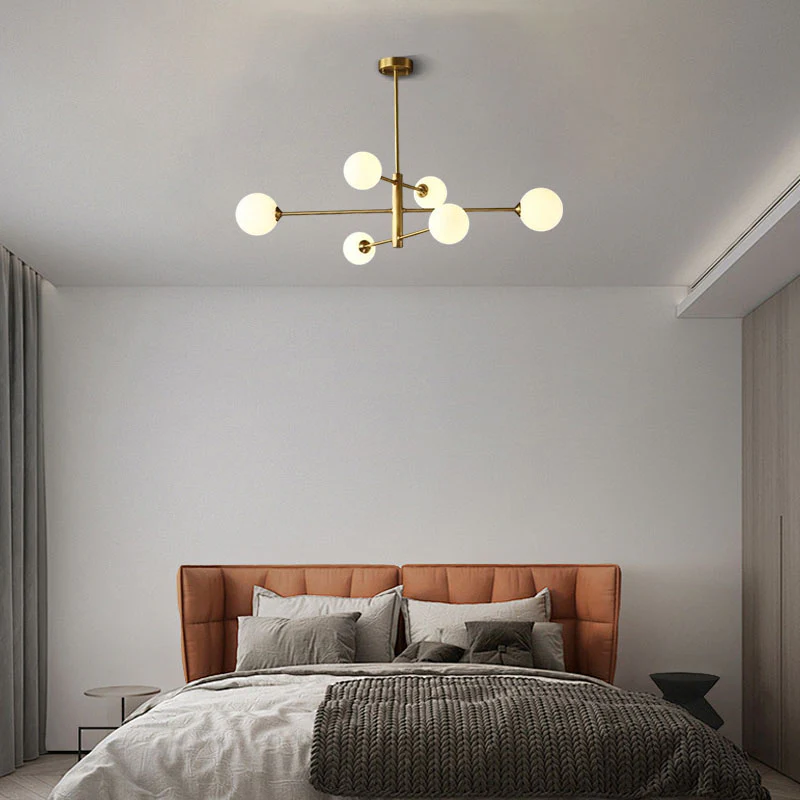
Serving as a Dramatic Centrepiece
A chandelier can be the focal point that takes your living room from ordinary to extraordinary. Picture a grand chandelier hanging in the centre of your space, drawing everyone’s attention the moment they walk in. It’s not just a light fixture; it’s a piece of art. Luxury hotels often use chandeliers in their lobbies to create a sense of grandeur, and fine dining restaurants rely on them to enhance the dining experience.
In residential spaces, homeowners are increasingly using chandeliers to add sophistication to their modern living rooms. Whether it’s a marble chandelier in a contemporary setting or a vintage design in a rustic home, these fixtures make a bold statement. They’re perfect for creating a dramatic transformation, turning your living room into a space that’s both stylish and unforgettable.
How to Choose the Right Size for Your Chandelier
Measuring Your Living Room
Considering Ceiling Height
Ceiling height plays a crucial role in determining the right chandelier size. A chandelier that’s too tall can overwhelm the space, while one that’s too short might go unnoticed. For standard 8-foot ceilings, aim to hang the chandelier so its bottom is about 7.5 feet from the floor. If your ceiling is higher, add 3 inches to the hanging height for every additional foot. For example, in a room with an 11-foot ceiling, the chandelier should hang approximately 8 feet from the floor.
If you’re placing the chandelier above a dining table or kitchen island, the rules change slightly. In this case, the bottom of the chandelier should sit 30 to 36 inches above the tabletop. This ensures it doesn’t obstruct views or feel intrusive while still providing adequate lighting.

Factoring in Room Dimensions
The size of your living room also affects your chandelier choice. A large room can accommodate a more dramatic fixture, while a smaller space benefits from a more modest design. To find the ideal diameter for your chandelier, measure the length and width of your room in feet. Add these numbers together, and convert the sum to inches. For instance, if your room is 16 feet long and 8 feet wide, the chandelier’s diameter should be around 24 inches.
Height is equally important. Multiply your room’s height in feet by 2.5 to determine the chandelier’s height in inches. For a room with an 11-foot ceiling, the chandelier should be about 27.5 inches tall. These calculations ensure your chandelier feels proportionate to the space, creating a balanced and harmonious look.
Size Guidelines for Chandelier Lights
Diameter and Height Recommendations
Choosing the right chandelier size doesn’t have to be complicated. Use the following table as a quick reference to guide your decision:
Measurement Type |
Calculation Method |
Example Calculation |
|---|---|---|
Diameter of Chandelier |
Sum the room's length and width in feet, then use that sum as the diameter in inches. |
16 ft + 8 ft = 24 ft; chandelier diameter = 24 in |
Height of Chandelier |
Multiply the room's height in feet by 2.5 to get the height in inches. |
11 ft * 2.5 = 27.5 in; chandelier height = 27.5 in |
Height for Hanging |
Bottom of chandelier should be 7.5 ft from the floor or 30-36 in from the tabletop. |
N/A |
Dining Table/Island Size Comparison |
Chandelier length/diameter should be 1/2 to 3/4 of the table or island length. |
60 in table; chandelier should be 30-45 in diameter |
These guidelines ensure your chandelier not only fits the room but also enhances its overall aesthetic.
Adjusting for Small or Open-Plan Spaces
Smaller rooms or open-plan layouts require a bit more creativity. In compact spaces, opt for a chandelier with a smaller diameter to avoid overwhelming the room. A minimalist design can also help maintain a sense of openness.
For open-plan areas, consider the visual flow between different zones. If your living room connects to a dining area or kitchen, choose chandeliers that complement each other in style and size. This creates a cohesive look while allowing each space to retain its unique character.
When in doubt, err on the side of caution. It’s easier to add visual impact with additional lighting or decorative elements than to scale back a chandelier that feels too large.
Selecting a Chandelier Style to Match Your Décor
Choosing the right chandelier style is essential for creating a cohesive and visually appealing living room. A well-matched chandelier can enhance your living room decor, acting as a focal point that ties the entire space together.
Complementing Your Interior Design Theme
Modern and Minimalist Chandeliers
If your modern living room features clean lines and a neutral colour palette, a modern chandelier is the perfect choice. These designs often emphasise simplicity, with geometric shapes and sleek finishes like brushed metal or frosted glass. They blend seamlessly into contemporary spaces, adding elegance without overwhelming the decor.
Mi+nimalist chandeliers are ideal for smaller rooms or open-plan layouts. Their understated designs ensure they complement the space without competing with other elements. For example, a linear chandelier with LED lights can provide functional lighting while maintaining a streamlined aesthetic.
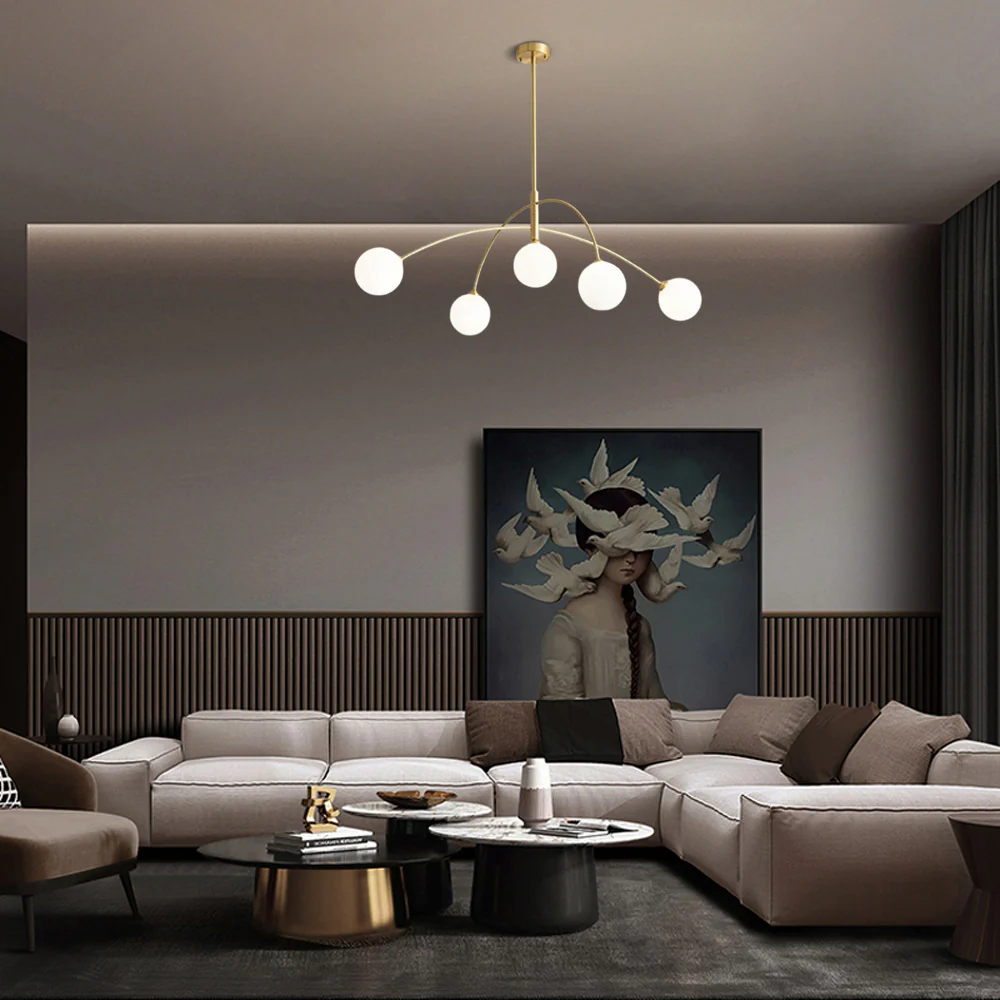
Modrn and Minimalist
Sign up to get 18% off your first purchase
Vintage and Traditional Styles
For a more classic look, vintage chandeliers bring timeless charm to your living room decor. These fixtures often feature intricate details, such as ornate metalwork or cascading crystals, which evoke a sense of grandeur. They pair beautifully with traditional furniture and rich colour schemes, creating a warm and inviting atmosphere.
Traditional chandeliers work well in larger spaces, where their elaborate designs can shine. Imagine a crystal chandelier hanging in a room with high ceilings—it’s a statement piece that exudes elegance and sophistication.
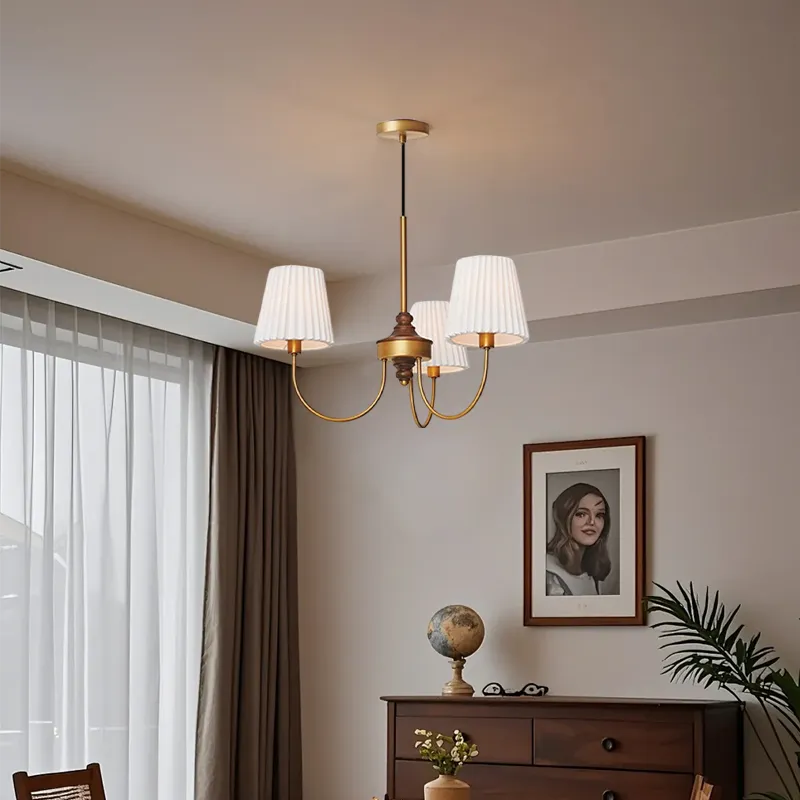
Vintange
Sign up to get 18% off your first purchasea
Rustic and Industrial Designs
Rustic and industrial chandeliers are perfect for adding character to your living room. Rustic designs often incorporate natural materials like wood or wrought iron, creating a cosy and earthy vibe. They’re ideal for spaces with farmhouse or cottage-style decor.
Industrial chandeliers, on the other hand, feature bold elements like exposed bulbs and metal finishes. These fixtures suit modern living rooms with urban or loft-inspired themes. They add a touch of edginess while maintaining functionality.
Tip: Define your interior style before choosing a chandelier. This ensures the fixture blends seamlessly with your existing decor and enhances the overall aesthetic.
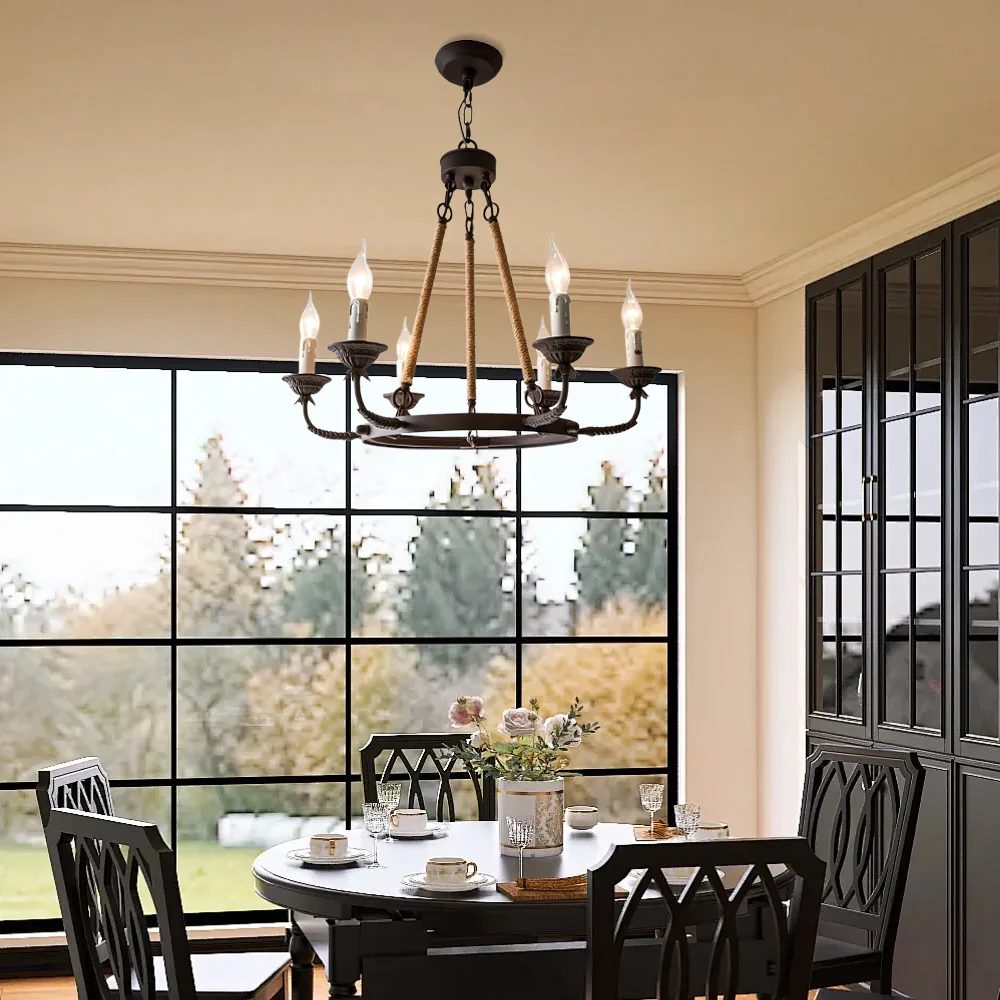
Choosing Materials and Finishes
Crystal, Glass, and Metal Options
The material of your chandelier significantly impacts its appearance and functionality. Crystal chandeliers are synonymous with elegance, refracting light to create a dazzling effect. They’re perfect for adding luxury to your living room decor.
Glass chandeliers offer versatility, with options ranging from frosted to coloured glass. They suit various styles, from modern to vintage. Metal chandeliers, such as those made from brass or stainless steel, provide a sleek and contemporary look. They’re durable and easy to maintain, making them a practical choice for busy households.
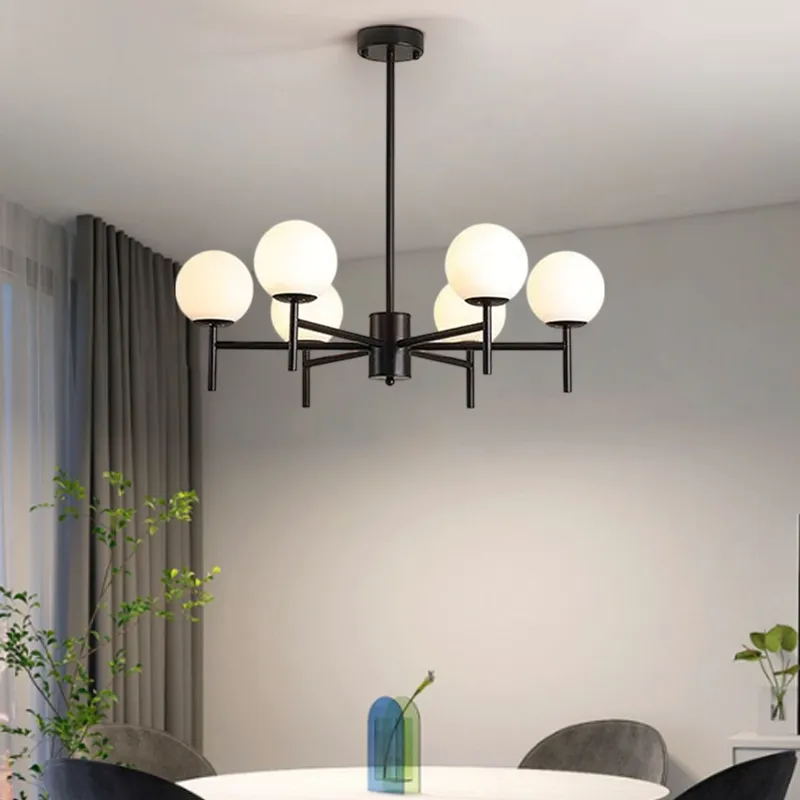
Best Materials
Sign up to get 18% off your first purchasea
Matching Colours and Textures
The finish of your chandelier should complement the colours and textures in your living room. For example, a bronze chandelier pairs well with warm tones, while a chrome finish suits cooler palettes.
Textures also play a role in creating harmony. A wooden chandelier can add warmth to a room with soft furnishings, while a metal fixture complements minimalist spaces. Customisation options allow you to tailor your chandelier to fit your interior theme perfectly.
Note: The trend towards personalised chandelier designs reflects a growing desire for unique lighting solutions. Customisation ensures your chandelier serves as a focal point while aligning with your living room decor.
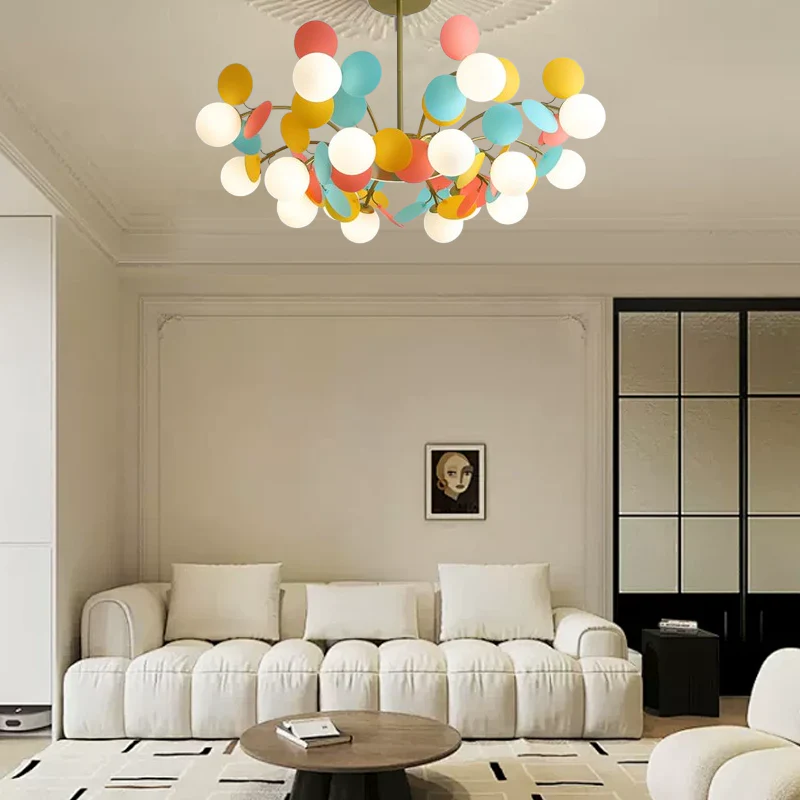
Understanding Lighting Needs for Your Living Room
Ambient vs Task Lighting with Chandeliers
When it comes to lighting your living room, it’s all about balance. Ambient lighting sets the overall mood, creating a soft and cosy atmosphere. Chandeliers excel at this, especially when paired with dimmable features. They spread light evenly across the room, making it feel warm and inviting. On the other hand, task lighting focuses on specific areas, like a reading nook or a workspace. While chandeliers aren’t typically used for task lighting, they can complement other fixtures, such as floor lamps or wall sconces, to provide a complete lighting solution.
A combination of ambient and task lighting works best in a modern living room. Ambient lighting creates a welcoming ambience, while task lighting ensures functionality. For instance, direct lighting is perfect for activities like reading, as it reduces eye strain and provides clarity. Meanwhile, indirect lighting from a chandelier minimises glare and enhances the room’s overall comfort. Together, these lighting types make your living room both practical and stylish.
Choosing the Right Bulbs for Chandelier Lights
Energy-Efficient LED Bulbs
Switching to LED bulbs for your chandelier is a smart move. LEDs are the most energy-efficient option, using up to 90% less energy than traditional incandescent bulbs. They’re also long-lasting, with a lifespan of up to 25,000 hours. This means fewer replacements and consistent brightness over time. For example, a 9W LED bulb consumes only about 16.4 kWh per year when used for five hours daily. Compare that to a 50W halogen bulb, which uses around 91.3 kWh annually, and the savings become clear.
LEDs also offer customisable colour temperatures, allowing you to tailor the lighting to your needs. Whether you prefer a warm, cosy glow or a bright, modern feel, there’s an LED bulb for every mood. Plus, their consistent illumination reduces eye strain, making your living room more comfortable for long periods.
Warm vs Cool Lighting Options
The colour temperature of your chandelier lights can dramatically affect the room’s vibe. Warm lighting, with its yellowish hue, creates a cosy and relaxing atmosphere. It’s perfect for evenings when you want to unwind or entertain guests. Cool lighting, on the other hand, has a bluish tint that feels crisp and energising. It’s ideal for modern spaces where you want a clean and vibrant look.
When choosing bulbs, consider the purpose of your living room. If it’s a space for relaxation, go for warm lighting. For a more dynamic and modern living room, cool lighting might be the better choice. Some LED bulbs even allow you to switch between warm and cool tones, giving you the flexibility to adapt the lighting to different occasions.
Benefits of Dimmable Chandeliers
Dimmable chandeliers are a game-changer for living room lighting. They let you adjust the brightness to suit your needs, whether you’re hosting a lively gathering or enjoying a quiet movie night. This flexibility not only enhances the room’s ambience but also helps save energy. Lowering the brightness reduces power consumption, making your chandelier more efficient.
Dimmable features also add a layer of sophistication to your decor. Imagine a crystal chandelier casting a soft, romantic glow during dinner or brightening up the room for a family game night. With a dimmable chandelier, you’re in control of the mood and functionality of your living room.
Tip: Pair your dimmable chandelier with LED bulbs for maximum energy efficiency and longevity. This combination ensures you get the best of both worlds—style and practicality.
Placement and Installation Tips for Chandeliers
Ideal Placement for Different Living Room Layouts
The placement of your chandelier can make or break the look of your modern living room. It’s not just about hanging it anywhere; strategic placement ensures it becomes a true focal point while enhancing the room’s functionality.
Centred Over a Coffee Table
Positioning your chandelier directly above a coffee table is a classic choice. This placement draws attention to the centre of the room, creating a balanced and cohesive look. It works particularly well in modern living rooms where the coffee table often anchors the seating arrangement. Ensure the chandelier hangs at a height that doesn’t obstruct views but still provides ample lighting. A good rule of thumb is to leave about 30 to 36 inches of clearance between the table and the bottom of the chandelier.
For open-plan living areas, centring the chandelier over the coffee table helps define the seating zone. Adjustable-height fixtures can also add versatility, allowing you to adapt the chandelier’s position based on the room’s layout or specific occasions.
Above a Seating Area
If your living room lacks a central coffee table, consider placing the chandelier above the main seating area. This approach creates a cosy and inviting atmosphere, perfect for entertaining guests or relaxing with family. A rectangular LED chandelier, for instance, can beautifully illuminate a sectional sofa or a cluster of armchairs.
In narrow rooms, avoid placing the chandelier too close to the walls. This prevents shadowing and ensures the light spreads evenly across the space. Instead, aim to position it centrally within the seating arrangement to maintain visual harmony.
Tip: Use a chandelier with dimmable lights to adjust the brightness based on the activity, whether it’s a lively gathering or a quiet evening.
Configuration Type |
Placement Guidelines |
|---|---|
Open-plan Living Areas |
Centre the chandelier over the primary seating arrangement to anchor the conversation area. |
Narrow Rooms |
Avoid placing the chandelier too close to walls to prevent shadowing and visual crowding. |
Installation and Safety Considerations
Installing chandelier lights requires careful planning and attention to detail. While it might be tempting to handle the installation yourself, hiring a professional ensures safety and proper execution.
Hiring a Professional Installer
Chandeliers are often heavy and require precise wiring, making professional installation a wise choice. A licensed electrician can handle the complexities, from securing the fixture to connecting the wires correctly. This reduces the risk of electrical shocks, fire hazards, or damage to your chandelier.
Note: Installation instructions often recommend professional help for direct-wired fixtures. This ensures compliance with safety standards and local building codes.
Here’s why hiring a professional is essential:
Prevent Electrical Shocks: Incorrect wiring can lead to dangerous shocks.
Reduce Fire Hazards: Overloaded circuits or improper bulb types can cause electrical fires.
Protect People and Property: Faulty installations can result in falling fixtures or damaged ceilings.
Ensuring Proper Ceiling Support
Before installing your chandelier, check that your ceiling can support its weight. Chandeliers, especially larger or crystal designs, can be surprisingly heavy. Reinforce the ceiling if necessary to prevent accidents.
Follow these steps for a safe installation:
Check State and Local Codes: Contact your local building department to understand specific requirements.
Switch Off the Power: Always turn off the electricity at the circuit breaker before starting.
Use Insulated Tools: These tools protect you from electrical shocks during installation.
A secure and well-installed chandelier not only enhances your modern living room but also ensures peace of mind.
Budgeting for Your Chandelier Lights
Budgeting for chandelier lights doesn’t have to feel overwhelming. With a little planning, you can find a stunning chandelier that fits your modern living room without breaking the bank. Let’s explore how to set a budget, balance quality with affordability, and discover cost-effective options.
Setting a Budget That Works for You
Before you start shopping, it’s important to decide how much you’re willing to spend. A clear budget helps you stay focused and prevents overspending. Think of it as a way to enjoy the process without unnecessary stress.
Here’s a quick guide to typical price ranges:
Category |
Price Range |
|---|---|
Budget Options |
|
Luxury Options |
Starting at $1,000 |
Energy Efficiency |
LED products consume up to 80% less energy than incandescent bulbs |
Consumer Preference |
75% prioritise design and aesthetics in chandelier selection |
Smart Features |
40% prefer smart chandeliers with app control |
If you’re aiming for a luxury chandelier, consider it an investment. High-quality options often last longer and add significant value to your home. However, even budget-friendly chandeliers can look elegant if chosen thoughtfully.
Balancing Quality and Affordability
Finding the perfect balance between quality and affordability is key. You don’t have to sacrifice style or durability to stick to your budget. Start by researching brands known for offering good quality at reasonable prices. Customer reviews can also provide valuable insights into the performance and longevity of a chandelier.
Here’s a simple three-step approach to help you:
Set a budget before you begin shopping.
Look for reputable brands that combine quality with affordability.
Read customer reviews to ensure you’re making a smart choice.
By following these steps, you’ll feel confident in your purchase and avoid overspending. Remember, a well-made chandelier doesn’t have to cost a fortune.
Exploring Cost-Effective Options
Pre-Owned or Vintage Chandeliers
Pre-owned or vintage chandeliers are excellent options if you’re looking for something unique and affordable. These pieces often have character and charm that newer designs can’t replicate. You can find them at antique shops, online marketplaces, or even estate sales.
When buying pre-owned, inspect the chandelier carefully. Check for any damage or missing parts, and ensure the wiring is safe. A little restoration work can transform a vintage chandelier into a stunning centrepiece for your modern living room.
DIY Customisation Ideas
If you’re feeling creative, why not customise a chandelier yourself? DIY projects allow you to personalise the design while saving money. For example, you could repaint a basic metal chandelier to match your living room’s colour scheme. Adding decorative elements like crystals or beads can also elevate its look.
DIY customisation is not only budget-friendly but also rewarding. You’ll end up with a one-of-a-kind piece that reflects your personal style. Plus, it’s a fun way to make your modern living room truly unique.
Tip: Whether you choose a pre-owned chandelier or a DIY project, always prioritise safety. Ensure the lights are properly wired and installed to avoid any issues.
Chandelier lights can truly transform your modern living room into a space that feels both stylish and personal. They add elegance, create a warm ambience, and serve as a stunning centrepiece. When choosing the perfect chandelier, think about its size, style, and placement. Don’t forget to consider your lighting needs and budget too. Take your time to explore options and pick a chandelier that reflects your taste and enhances your living space. After all, the right choice can make your home feel even more inviting.
Tip: A well-chosen chandelier doesn’t just light up your room—it lights up your life!
FAQ
What is the best way to clean a chandelier?
Use a soft cloth or a feather duster to remove dust. For a deeper clean, turn off the power, remove the bulbs, and wipe the chandelier with a damp cloth. Avoid harsh chemicals to protect the finish.
How high should I hang a chandelier in my living room?
Hang it so the bottom is about 7.5 feet from the floor. If it’s above a coffee table, leave 30–36 inches of clearance. This ensures the chandelier doesn’t obstruct views or feel too low.
Can I install a chandelier myself?
You can, but hiring a professional is safer. Chandeliers often require precise wiring and proper ceiling support. A licensed electrician ensures the installation is secure and meets safety standards.
What type of bulbs work best for chandeliers?
LED bulbs are the best choice. They’re energy-efficient, long-lasting, and available in various colour temperatures. Choose warm light for a cosy feel or cool light for a modern vibe.
Are chandeliers suitable for small living rooms?
Yes, they are! Opt for a smaller chandelier with a minimalist design. It adds elegance without overwhelming the space. Ensure it complements the room’s proportions for a balanced look.
How do I choose a chandelier that matches my décor?
Match the chandelier’s style and materials to your room’s theme. For modern spaces, go for sleek designs. Rustic or vintage styles suit traditional interiors. Consider finishes and colours that blend with your furniture.
Do chandeliers provide enough light for a living room?
Yes, but it depends on the size and bulb type. For larger rooms, combine the chandelier with other light sources like floor lamps or wall sconces. This creates a layered lighting effect.
Can I use a dimmer switch with my chandelier?
Absolutely! A dimmer switch lets you adjust the brightness to suit different moods. Pair it with dimmable LED bulbs for maximum flexibility and energy savings.

